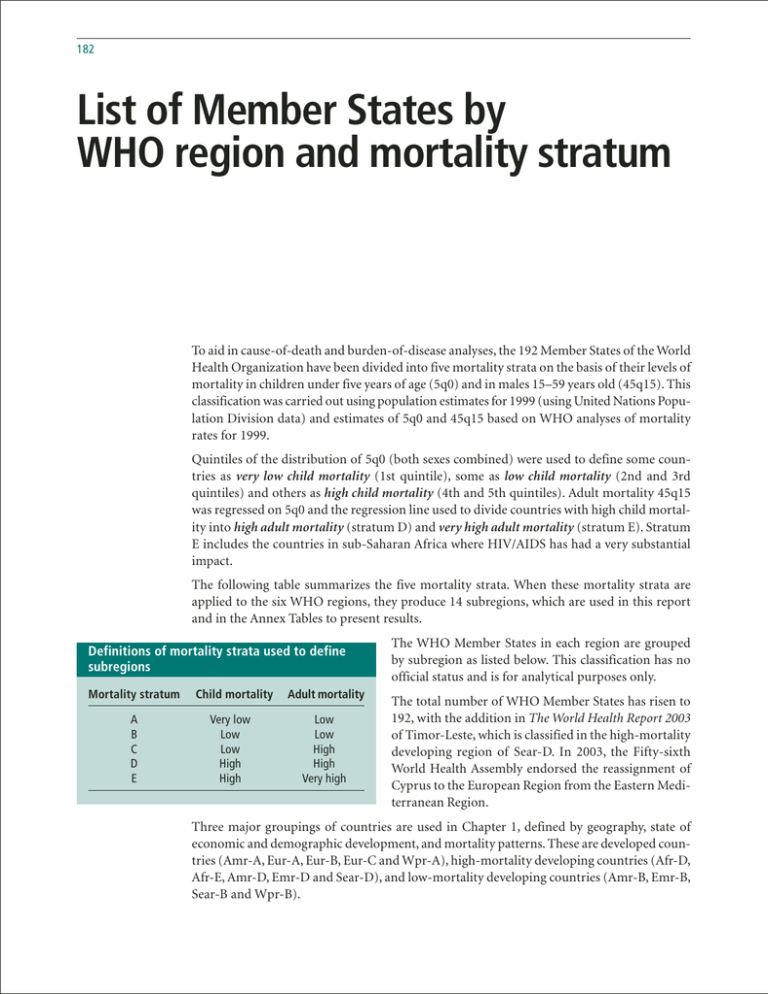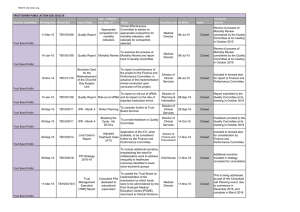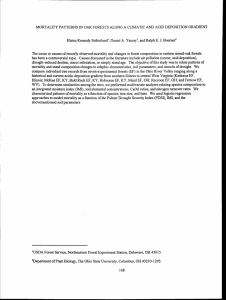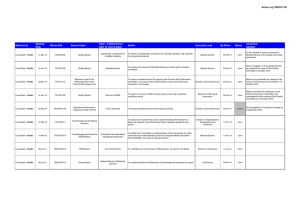List of Member States by WHO region and mortality stratum
advertisement

182 The World Health Report 2003 List of Member States by WHO region and mortality stratum To aid in cause-of-death and burden-of-disease analyses, the 192 Member States of the World Health Organization have been divided into five mortality strata on the basis of their levels of mortality in children under five years of age (5q0) and in males 15–59 years old (45q15). This classification was carried out using population estimates for 1999 (using United Nations Population Division data) and estimates of 5q0 and 45q15 based on WHO analyses of mortality rates for 1999. Quintiles of the distribution of 5q0 (both sexes combined) were used to define some countries as very low child mortality (1st quintile), some as low child mortality (2nd and 3rd quintiles) and others as high child mortality (4th and 5th quintiles). Adult mortality 45q15 was regressed on 5q0 and the regression line used to divide countries with high child mortality into high adult mortality (stratum D) and very high adult mortality (stratum E). Stratum E includes the countries in sub-Saharan Africa where HIV/AIDS has had a very substantial impact. The following table summarizes the five mortality strata. When these mortality strata are applied to the six WHO regions, they produce 14 subregions, which are used in this report and in the Annex Tables to present results. Definitions of mortality strata used to define subregions Mortality stratum A B C D E Child mortality Very low Low Low High High Adult mortality Low Low High High Very high The WHO Member States in each region are grouped by subregion as listed below. This classification has no official status and is for analytical purposes only. The total number of WHO Member States has risen to 192, with the addition in The World Health Report 2003 of Timor-Leste, which is classified in the high-mortality developing region of Sear-D. In 2003, the Fifty-sixth World Health Assembly endorsed the reassignment of Cyprus to the European Region from the Eastern Mediterranean Region. Three major groupings of countries are used in Chapter 1, defined by geography, state of economic and demographic development, and mortality patterns. These are developed countries (Amr-A, Eur-A, Eur-B, Eur-C and Wpr-A), high-mortality developing countries (Afr-D, Afr-E, Amr-D, Emr-D and Sear-D), and low-mortality developing countries (Amr-B, Emr-B, Sear-B and Wpr-B). List of Member States by WHO region and mortality stratum 183 WHO Member States, by region and mortality stratum Region and mortality stratum Description Broad grouping Member States Africa Afr-D Africa with high child and high adult mortality High-mortality developing Algeria, Angola, Benin, Burkina Faso, Cameroon, Cape Verde, Chad, Comoros, Equatorial Guinea, Gabon, Gambia, Ghana, Guinea, GuineaBissau, Liberia, Madagascar, Mali, Mauritania, Mauritius, Niger, Nigeria, Sao Tome and Principe, Senegal, Seychelles, Sierra Leone, Togo Africa with high child and very high adult mortality High-mortality developing Afr-E Botswana, Burundi, Central African Republic, Congo, Côte d’Ivoire, Democratic Republic of the Congo, Eritrea, Ethiopia, Kenya, Lesotho, Malawi, Mozambique, Namibia, Rwanda, South Africa, Swaziland, Uganda, United Republic of Tanzania, Zambia, Zimbabwe Americas Amr-A Americas with very low child and very low adult mortality Developed Canada, Cuba, United States of America Americas with low child and low adult mortality Low-mortality developing Amr-B Antigua and Barbuda, Argentina, Bahamas, Barbados, Belize, Brazil, Chile, Colombia, Costa Rica, Dominica, Dominican Republic, El Salvador, Grenada, Guyana, Honduras, Jamaica, Mexico, Panama, Paraguay, Saint Kitts and Nevis, Saint Lucia, Saint Vincent and the Grenadines, Suriname, Trinidad and Tobago, Uruguay, Venezuela (Bolivarian Republic of) Americas with high child and high adult mortality High-mortality developing Bolivia, Ecuador, Guatemala, Haiti, Nicaragua, Peru Amr-D South-East Asia Sear-B South-East Asia with low child and low adult mortality Low-mortality developing Indonesia, Sri Lanka, Thailand South-East Asia with high child and high adult mortality High-mortality developing Sear-D Bangladesh, Bhutan, Democratic People’s Republic of Korea, India, Maldives, Myanmar, Nepal, Timor-Leste Europe Eur-A Europe with very low child and very low adult mortality Developed Andorra, Austria, Belgium, Croatia, Cyprus, Czech Republic, Denmark, Finland, France, Germany, Greece, Iceland, Ireland, Israel, Italy, Luxembourg, Malta, Monaco, Netherlands, Norway, Portugal, San Marino, Slovenia, Spain, Sweden, Switzerland, United Kingdom Europe with low child and low adult mortality Developed Eur-B Albania, Armenia, Azerbaijan, Bosnia and Herzegovina, Bulgaria, Georgia, Kyrgyzstan, Poland, Romania, Slovakia, Tajikistan, The former Yugoslav Republic of Macedonia, Serbia and Montenegro, Turkey, Turkmenistan, Uzbekistan Europe with low child and high adult mortality Developed Eur-C Belarus, Estonia, Hungary, Kazakhstan, Latvia, Lithuania, Republic of Moldova, Russian Federation, Ukraine Eastern Mediterrannnean Emr-B Eastern Mediterranean with low child and low adult mortality Low-motality developing Bahrain, Iran (Islamic Republic of), Jordan, Kuwait, Lebanon, Libyan Arab Jamahiriya, Oman, Qatar, Saudi Arabia, Syrian Arab Republic, Tunisia, United Arab Emirates Eastern Mediterranean with high child and high adult mortality High-mortality developing Emr-D Afghanistan, Djibouti, Egypt,* Iraq, Morocco, Pakistan, Somalia, Sudan, Yemen Western Pacific with very low child and very low adult mortality Developed Australia, Brunei Darussalam, Japan, New Zealand, Singapore Western Pacific with low child and low adult mortality Low-mortality developing Cambodia,** China, Cook Islands, Fiji, Kiribati, Lao People’s Democratic Republic,** Malaysia, Marshall Islands, Micronesia (Federated States of), Mongolia, Nauru, Niue, Palau, Papua New Guinea,** Philippines, Republic of Korea, Samoa, Solomon Islands, Tonga, Tuvalu, Vanuatu, Viet Nam Western Pacific Wpr-A Wpr-B * Following improvements in child mortality over recent years, Egypt meets criteria for inclusion in subregion Emr-B with low child and low adult mortality. Egypt has been included in Emr-D for the presentation of subregional totals for mortality and burden to ensure comparability with previous editions of The World Health Report and other WHO publications. ** Although Cambodia, the Lao People’s Democratic Republic, and Papua New Guinea meet criteria for high child mortality, they have been included in the Wpr-B subregion with other developing countries of the Western Pacific Region for reporting purposes. 184 The World Health Report 2003






